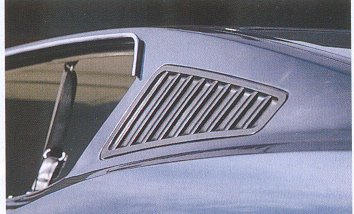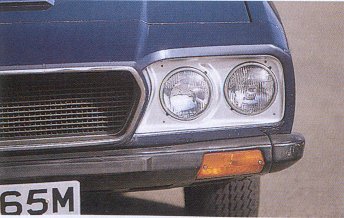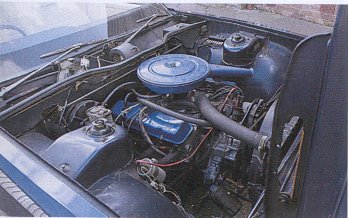Leyland P76 Owners 2004 |
Publications |
|

Article of Dave Morton Force 7 UK
Scanned Magazine




Reproduced text

- Forget your Ferraris and leave those Lambos alone: if you want to turn heads in the British midlands, you should be driving a Leyland. Not an old Princess or Rover SD1 (although these too have now acquired curiosity value) but an Australian-built Leyland P76, and preferably this ultra-rare, so-cool-it-hurts Force 7 coupe.
- Unfortunately, unless you buy this example you're never likely to get the chance. Only 10 Force 7's escaped the factory crusher and this is the only one that made it to the UK. But its not rarity that turns people's heads: it's the sight of those familiar Leyland 'plughole' logos on a coupe that has all the compact elegance of a Mach I Mustang.
-
- The P76 occupies a unique place in Australian motoring history. Leyland's too, because it was the only Leyland designed from the ground up to meet the needs of the Australian market. Until the early'70s, Aussies had to make do with cheaply reworked versions of BL's home-market products such as the 1800 and Marina. Little had been done to re-engineer them for the bush rather than Birmingham.
- BMC's Australian management realised that pommie hybrids such as the Morris Marshall (a thinly disguised Austin A95) or the Austin Tasman/Kimberley (six-cylinder versions of the Austin 1800) were never going to have more than peripheral appeal to Commonwealth buyers, so in the late 60's they made plans to introduce two locally designed new models. One would be a compact, the other a mid-size saloon.
- The compact would have been pretty similar to the forthcoming Morris Marina, so that was dropped and resources funnelled into the bigger car. Michelotti won the contract for the styling - he was well in with BL at the time, having just done the Mks I and II Triumph 20Oos - and the P76 project was officially green- lighted, albeit reluctantly, by British Leyland. In fact the first two prototypes were built at the MG factory in Abingdon.
- While the P76 was officially styled by Michelotti, Leyland Australia's management couldn't resist reshaping the car to suite its own perceptions of what would appeal to Aussies. The story goes that an executive saw the P76 blueprints on the wall, decided it needed a bigger boot and gave it the J-Lo treatment there an then. That's why you can drop a 44-gallon oil drum into a P76 boot and still close the lid.
- So the styling may have been compromised, but at least the P76 fulfilled the brief of being an Aussie car built for Aussie conditions. Intensive outback testing proved that it was tough enough to barrel along dirt roads for hours on end yet it handled remarkably well. There was rack-and-pinion steering and simple but effective live-axle rear suspension.
- The P76 was also comparatively light, so performance was good from the optional 2.6-litre straight-six or 4.4 litre V8 engines, and the front disc brakes were a cut above the opposition's all-drums set-ups.
- The public was certainly impressed. Within a week of launch in June 1973 more than 2000 orders had been taken and there was plenty of interest from fleet buyers, too. The Australian motor magazines gave it a good reception, Wheels voting it Car of the Year, despite a few grumbles about the styling and build quality.
- Sadly, it was all down hill from then on. Leyland Australia was the victim of its own success and couldn't meet customer demand, partly due to shortages from its component suppliers. Fed-up with waiting for cars they'd ordered months ago, the punters turned to rival models from Chrysler, Holden and Ford (which the parts suppliers, with a keen sense of the way the wind was blowing for Leyland, were favouring anyway).
- The P76s timing couldn't have been worse, either. The cost of car imports, notably from Japan, was reduced to curb inflation and British Leyland had problems of its own back home. Faced with mounting debts and no prospect of a bail-out, Leyland Australia went to the wall within 16 months of the P76 launch. The Australian Government paid $25 million for the factory at Zetland, Sydney and for the remaining unsold cars, many of which ended up as State or Local Authority transport.
- By then, however, 60 examples of the P76s coupes spin-off had been built. The Force 7 was a sporty hatchback with a massive loadspace, like a Mad Max take on the Datsun 280ZX.
- Running gear was the same as the saloon but the exterior metalwork was completely different, and, unlike the saloon, the Force 7 could be tarted up with optional alloy wheels and a louvred rear window.
- All but 10 of these coupes were scrapped when Leyland Australia folded, one of the survivors having already been shipped to the UK where, incredibly, it was used for a while by Lord 'bling-bling' Stokes himself. It ended up at a Sotheby's auction in the early'80s, where Nottingham-based motor factor David Morton bought it on a whim.
- Like all the remaning coupes, David's Force 7 has a V8 and is badged as a Force 7V to distinguish it from the cheaper, straight-six-powered base model. It's relatively subdued for a Force 7, being painted a dark blue metallic shade known as Omega Navy - other P76 colours included a brown called, without apparent irony Oh Fudge, and a bright orange that has surely the most-laboured pun ever given to a car colour: Home on th'Orange. It won't surprise you to learn that interior trim options include Plum Loco and Peel me a Grape.
- Inside, those crazy Aussies continued to let their imaginations ran riot. The crash pad on the steering wheel boss is shared like a coffin and the stylised letter 'L' on the gear selector cover plate is straight from the Hanna-Barbera cartoon school of typography. Unusually, David's car has a plasticised fake machine turned applique stuck over the dash. It's authentic but horrible, and one wonders what Lord Stokes must have thought.
- But let's stop knocking this car, because once you get beyond the detailing there's some genuinely good underneath. Loads of room, for a start: this is a big car for big men in a big country. More significantly, it's also good to drive.
- First thing to strike you is the quality of the steering. It's sharp, and it's not heavy even though it lacks power assistance. What's more the lock is incredible. You wouldn't believe something this clumsy-looking could turn in such a small area.
- The ride is soft, as expected, but that doesn't mean the Force 7 handles like a
- road train in a tight corner. A privateer P76 set some of the fastest stage times during the 1974 World Cup Rally and, on city roads at least, the Force 7 can still mix it with today's Europeans. Sheer size is the limiting factor especially since every external part is unique to the car. Nothing is shared British Leyland products and even the rear lights are different from a P76 saloon's. Fortunately, the Force 7 is such an attention grabber that people can't fail to notice it. As we wait at the lights in Nottingham city centre, a young black dude crosses in front and gives it the once-over before nodding his considered approval. Doubtless he, and we, would appreciate a bit more noise from the 4.4-litre V8 - an Australia-only variant of Rover's favourite engine because the single-pipe exhaust emits the most discreet of burbles, and a car this outrageous-looking needs to talk the talk as well as walk the walk.
- However, while we didn't put it to the test, there's little doubt the Force 7 could fight up its rather undersized 185xl4 rear radials on demand, and the stepped selector gate of the automatic gearbox makes it easy to drive like a manual. In the early'80s, when P76 values were at rock bottom, impecunious Aussie enthusiasts discovered that the 4.4-litre P76 saloon made a cheap and competitive rival to V8 Fairmonts and Monaros.
- Now the P76 range is being reappraised. It's no longer seen as just another glorious Australian failure - "like Gallipoli", as Leyland PR man Will Hagon puts it - but as a promising newcomer that never got the break it deserved. There's even an example on display in the Powerhouse Industrial museum in Sydney. Today the slogan used to sell the P76 back in 1973 seems truer than ever: Anything but Average.
10 THINGS YOU DIDN'T KNOW
- 1/ Legend has it that the P76 code was chosen by Lord Stokes, who took the first digits of the army service number engraved on the back of his watch.
- 2/ A P76 finished 13th on the 1974 World Cup Rally. Entered by Evan Green and John Bryson, it was the fastest car on the 72km Targa Florio special stage.
- 3/ With minimal modifications, the P76 could be turned into a boat. Owners discovered that, by sealing a few compartments and adding an outboard, they could sail it.
- 4/ Factory-fit accessories available for the P76 included a mesh or sheet metal windscreen visor and a kit to fit an illuminated taxi sign on the roof.
- 5/ Three prototype station wagons were built, with rear ends reminiscent of the Vauxhall PC Cresta estate. Two were scrapped and the third sold to a Sydney motor factor.
- 6/ The first full history of the P76 was 2002's Leyland P76: the definitive guide to Australia's most controversial car, by Hal Maloney, ISBN 094 70799 4 7. 7/ To publicise the car's launch, a promotional 'thriller' was filmed inside the Zetland factory. It was called The Car Makers and shown on prime-time television.
- 8/ Leyland Australia hoped to export the P76 to Britain and sent two cars to the UK for press evaluation.
- 9/ Unused alloy wheels and trim from the aborted Force 7 coupes were used to produce Targa Florio dress-up kits for the P76 in summer 1974. About 600 were sold.
- 10/ C&SC editor James Elliott briefly owned a P76 during a gap year in Australia. Bought for 200 pound, the six-cylinder car repeatedly blew head gaskets. "It was horrible," he says.
Technical Specifications
LEYLAND FORCE 7
- Engine all-alloy, ohv V8, 4416cc, Stromberg WW carb, or in-line iron block, alloy head ohc 'six', 2623cc, two SU HS6 carbs
- Max power V8 192bhp a 4250rpm; S6 121 bhp a 45OOrpm
- Max torque V8 2851b ft a 25OOrpm S6 1651b ft o 20OOrpm
- Transmission four-speed manual or three-speed Borg Warner automatic - Suspension: front MacPherson struts, anti-roll bar rear live axle, trailing arms, coil springs
- Steering rack and pinion
- Brakes discs front, drums rear, with servo
- Weight 28381b (V8 saloon)
- 0-60mph 8.9 secs (saloon; coups not tested)
- Top speed 105mph (as above)
- Numbers produced 60 (Force 7), est 18,000 (P76)
| |
|
|
This site is hosted and maintained by NIGHTWALKER.BIZ  and powered by the Penguin |
Last updated
Jan, 2006 |
This web site may contain Copyright material
If you find any problems with the site, please email the
Web Editor  |
|












